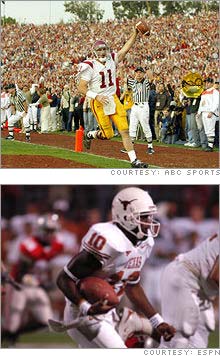Bringing Moneyball to the NFL draft
Some football outsiders say NFL teams need to adopt a new way of looking at college players in order to be successful in the draft.
NEW YORK (CNNMoney.com) - This weekend's biggest sporting event requires no physical exertion, only mental activity. But are enough mental gymnastics being performed in preparation for the National Football League draft? As general managers and scouting staffs huddle up to try and find the best player, they'll pore over players' 40-yard dash times and stats collected during college football games against opponents who aren't of the caliber of even the weakest of the NFL teams.
Relying on such stats is one reason that there have been so many high-profile bad draft picks. But it doesn't have to be that way. (For a look at SI.com's list of worst NFL draft picks, click here.) In other team sports, there has been a greater emphasis on strict statistical analysis, rather than imprecise scouting evaluations, to determine the most valuable players to pick in a draft or sign to a free agent contract. That's especially the case in baseball. Football has been somewhat slower than baseball to adopt this approach, epitomized by the still somewhat controversial 2003 book "Moneyball," by Michael Lewis, which looked at how the low-revenue Oakland Athletics were using statistical analysis to field competitive teams against opponents with much deeper pockets. There has been a move among some football teams to focus on more innovative statistics than the ones you're likely to hear cited by the "experts" during Saturday's draft day coverage. But some of the outsiders who have looked at player evaluation in the NFL believe the league still has a long way to go. Lewis is one of them. He is working on a new book which, like "Moneyball," is a behind closed doors story about how NFL teams select and value players. After looking at the league's player valuation process, he concludes that what football teams are doing to judge talent really isn't working, at least not nearly as well as the teams would have you believe it does. "The compensation structure that emerges (from the draft) indicates (teams) know who's the next great NFL player. That's crazy," said Lewis. "If you have the No. 1 pick in the draft, the best thing you could do is trade it away and get a lot of lower picks. You want to acknowledge you don't know who is going to work out, want to spread out your picks." Lewis said differences in the game, not in intelligence of the front offices, is the reason that Moneyball-like statistical analysis has been slower to catch on in football. In baseball, the most important stats give a pretty good look at the game's key one-on-one match up between pitchers and batters. In football, the outcome of every play includes contributions by 22 different players, making a single player's stats, such as yards per carry, completions or tackles somewhat harder to value. But just as much of the groundbreaking statistical analysis in baseball was first done by those who didn't work for any major league teams, there are new football metrics being compiled by some league outsiders as well. One of those is ProTrade, a Web site that uses "Moneyball" type analysis as the basis for a new kind of fantasy sports game. It places a valuation on a players' contribution to a team's success, and then allows its clients to buy and sell those players like a stock, using a virtual currency. So how does the site answer one of the biggest questions of this year's draft: Who's the better quarterback pick, USC's Matt Leinart or Texas' Vince Young? ProTrade comes down clearly in Leinart's favor. To arrive at that answer, the site looked at stats such as first down conversion rates on different downs, how successful the quarterback's team is it is close to the goal line and how the quarterback fared against different quality defenses, rather than focusing on simple completion and yardage stats. The co-founders of ProTrade, former agent Mike Kerns and blackjack whiz Jeff Ma, agree with Lewis that there are a lot of problems with football stats. "It's an inexact science," said Ma. "In baseball, when you get more and more data, you get better information. In football, you get more data and it almost begs more questions." Still Ma and Kerns say the one thing that's clear is that many of the stats you'll hear cited during the draft do little to predict a players' success. "There's no correlation between 40 (yard dash) times and success in NFL," said Ma. "I'm convinced there's more efficient stats for all the positions," said Kerns. "The key is to collect better data than is furnished by the NCAA." But Ma, Kerns and Lewis also agree with my suggestion to them that the economic structure of the NFL probably works against there ever being a true "Moneyball" team in football. Billy Beane, the groundbreaking general manager of the Oakland A's, helped create the new system for evaluating talent because he had to if the team was going to be anything more than a whipping boy of larger market teams. Revenue sharing, salary caps and non-guaranteed contracts in the NFL mean that none of the league's front offices have that important incentive to innovate. And even teams that do innovate will receive a much lower economic payoff from any on-field success that comes from their off-field analysis. ________________________ For more on ProTrade, click here. For a look at whether Moneyball can survive in baseball, click here.
For more news about the business of sports, click here. |
| |||||||||||||



